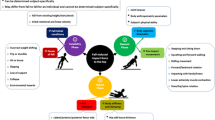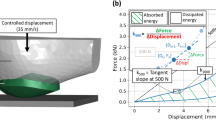Abstract
The purpose of this study is to evaluate hip fracture risk in relation to fall direction, and to elucidate factors that influence the impact force in falls on the hip. Eight healthy volunteers performed deliberate falls in three directions (lateral, posterolateral and posterior) on a force platform covered by a mattress of 13 cm thickness. Fall descent motions and impact postures were examined by a three-dimensional analyzer. The maximum ground force reaction, velocity of the greater trochanter at impact, and activity of quadriceps and gluteus medius were measured. In all trials of lateral and posterolateral falls, but not of posterior falls, the subjects hit their greater trochanter directly on the mattress. The impact forces were between 2,000 N and 4,000 N. Posterolateral falls showed significantly higher velocity at impact than did posterior falls. The height and the lower limb length exhibited positive correlations with the impact force in all directions of fall. In the lateral fall, there was a positive correlation between the activity of quadriceps and the impact force. In view of the impact point, force, and velocity, the posterolateral fall seemed to carry the highest risk of hip fracture.





Similar content being viewed by others
References
Hayes WC, Myers WR (1997) Biomechanical considerations of hip and spine fractures in osteoporotic bone. AAOS Instructional Course Lecture 46:431–438
Province MA, Hadley EC, Hornbrook MC et al (1995) The effects of exercise on fall in elderly patients. A preplanned meta-analysis of the FICSIT trial. JAMA 273:1341–1347
Campbell AJ, Robertson MC, Gardner MM et al (1997) Randomised controlled trial of a general practice programme of home based exercise to prevent falls in elderly women. BMJ 315:1065–1069
Close J, Ellis M, Hooper R et al (1999) Prevention of falls in the elderly trial (PROFET): a randomized controlled trial. Lancet 53:93–97
Lauritzen JB, Petersen MM, Lund B (1993) Effect of external hip protectors on hip fractures. Lancet 341:11–13
Ekman A, Mallmin H, Michaelsson K et al (1997) External hip protectors to prevent osteoporotic hip fractures. Lancet 350:563–564
Kannus P, Parkkari J, Niemi S et al (2000) Prevention of hip fracture in elderly people with use of a hip protector. N Engl J Med 343:1506–1513
Harada A, Mizuno M, Takemura M et al (2002) Hip fracture prevention trial using hip protector in Japanese nursing homes. Osteoporos Int 12:215–221
Hausenlmann HJ, Rizzoli R (2003) A comprehensive review of treatments for postmenopausal osteoporosis. Osteoporos Int 14:2–12
Schwartz AV, Kelsey JL, Sidney S et al (1998) Characteristics of falls and risk of hip fracture in elderly men. Osteoporos Int 8:240–246
Greenspan SL, Myers ER, Kiel DP et al (1998) Fall direction, bone mineral density, and function: risk factors for hip fracture in frail nursing home elderly. Am J Med 104:539–545
Iida H, Nakamura T, Kanzaki H et al (1997) A new gait analysis system using computer graphics. Journal of Japanese Society for Clinical Biomechanics 18:373–377
Nevitt, MC, Cummings SR (1993) Type of fall and risk of hip and wrist fracture: the study of osteoporotic fractures. J Am Geriatr Soc 41:1226–1234
Greenspan SL, Myers WR, Maitland LA et al (1994) Fall severity and bone mineral density as risk factors for hip fracture in ambulatory elderly. JAMA 271:128–133
Lozt JC, Hayes WC (1990) The use of quantitative computed tomography to estimate risk of fracture of the hip from falls. J Bone Joint Surg Am 72:689–700
Courtney AC, Wachtel EF, Myers ER et al (1995) Age-related reductions in the strength of the femur tested in a fall-loading configuration. J Bone Joint Surg Am 77:387–395
Okuizumi H, Harada A, Iwata H et al (1998) Effect on the femur of a new hip fracture preventive system using dropped-weight impact testing .J Bone Miner Res 13:1940–1944
Harada A, Matsui Y (2002) Falls and fracture in elderly people. Orthopaedic Surgery and Traumatology 45:715–722
Nikaido T, Sakaguchi K, Oka M et al (2000) Biomechanical research of the femoral neck fracture. Journal of Japanese Society for Clinical Biomechanics 21:385–391
Oka M, Shima H, Hayami N (2003) Study on falling. Journal of Japanese Society for Clinical Biomechanics 24:314–48
Robinovitch SN, Hayes WC, McMahon TA (1991) Prediction of femoral impact forces in falls on the hip. J Biomech Eng 113:366–374
Robinovitch SN, McMahon TA, Hayes WC (1995) Force attenuation in trochanteric soft tissue during impacts from a fall. J Orthop Res 13:956–962
Grisso JA, Kelsey JL (1997) Risk factors for hip fracture in men. Am J Epidemiol 145:786–793
Cummings SR, Nevitt MC, Browner WS et al (1995) Risk factors for hip fracture in white women. N Engl J Med 332:767–773
Kroonenberg AJ, Hayes WC, McMahon TA (1996) Hip impact velocities and body configurations for voluntary falls from standing height. J Biomech 29:807–811
Sabick MB, Hay JG, Goel VK et al (1999) Active responses decrease impact forces at the hip and shoulder in falls to the side. J Biomech 32:993–998
Acknowledgements
We thank Atsushi Iwashita, R.P.T., and Minako Hirakawa, R.P.T., for their helpful discussions and technical assistance. We also thank all the volunteers for participating in the study
Author information
Authors and Affiliations
Corresponding author
Rights and permissions
About this article
Cite this article
Nankaku, M., Kanzaki, H., Tsuboyama, T. et al. Evaluation of hip fracture risk in relation to fall direction. Osteoporos Int 16, 1315–1320 (2005). https://doi.org/10.1007/s00198-005-1843-2
Received:
Accepted:
Published:
Issue Date:
DOI: https://doi.org/10.1007/s00198-005-1843-2




